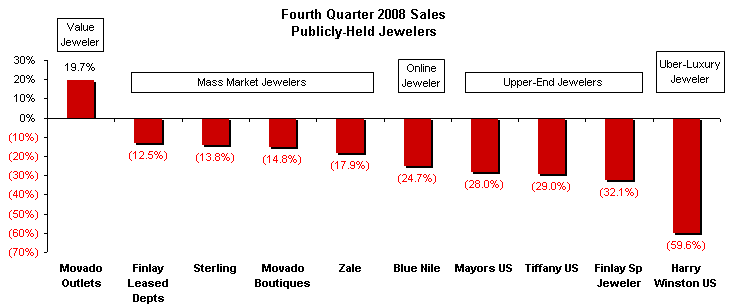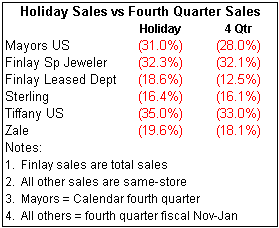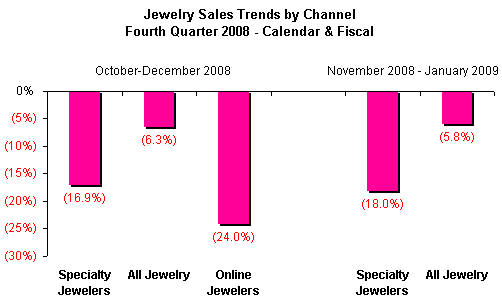IDEX Online Research: History Didn’t Predict Jewelry Sales Trends in Q4
April 16, 09
There is an old adage in the jewelry industry that upper-end jewelers out-performed mass market jewelers in a recessionary environment. There were even statistics which supported this old adage. But in the current recessionary environment of the fourth quarter of 2008, the economy dealt the jewelry industry a surprise: history and old adages were not good predictors of consumer demand and shoppers’ spending.
We now have a final tally on fourth quarter sales trends from the publicly held companies, and their sales results confirm the fact that consumer demand for jewelry was not only out-of-the-norm, but was not predictable in the current recession.
Highlights of Fourth Quarter Jewelry Sales in the U.S. Market
There were several key points that characterized fourth quarter sales – both for the calendar period (October-November-December 2008) as well as the fiscal period (November 2008-December 2008-January 2009). These key points are as follows:
- High-end specialty jewelers’ sales declined worse than the industry average. This was a notable departure from historical trends.
- Mass market specialty jewelers’ sales declined less than the industry average. This was highly unusual.
- Consumers were willing to spend money on jewelry, though total expenditures were below prior years’ levels. During the fourth quarter of 2008, American consumers spent 80 percent-to-95 percent of the levels in the prior year, based on total industry sales figures.
- It was a “Price & Item” fourth quarter. Jewelers who reported the strongest sales on a relative basis promoted specific items at sharp price points. Emotional and institutional advertising didn’t seem to motivate consumers to spend money on jewelry.
- Consumers spent much more heavily when jewelers offered the perception of value.
- No longer can we make the claim, “No publicly held specialty posted a sales gain during the fourth quarter of 2008.” The Movado Outlet stores posted a solid sales gain – +20 percent – due to two factors: 1) they offer the perception of value; and 2) they introduced many new jewelry items during 2008.
The graph below illustrates the one over-riding key trend from the fourth quarter: that upper-end jewelers under-performed and mass market jewelers out-performed. All sales figures are for the jewelers’ U.S. operations only.

Source: Company Reports
Fourth Quarter Jewelry Industry Sales Results
The U.S. Department of Commerce has made at least one revision to all jewelry industry sales statistics, both for the total jewelry industry as well as for specialty jewelers. Thus, they are technically not “preliminary figures” any longer. However, we continue to question the Commerce Department’s tally for total jewelry sales – we think they are worse than the Commerce Department has reported – but we really don’t have a more reliable measure of industry performance. We are expecting additional sales revisions at the end of April, so it will be interesting to see how much the numbers change.
Based on the latest government data, here are the sales trends for the jewelry industry in the fourth calendar quarter of 2008 as well as the fourth fiscal quarter (November-December-January) ending January 2009.
|
|
Why Were Sales So Weak in the Fourth Quarter?
The reasons for weak consumer demand have been debated ad nauseam for months. For jewelers, we think there were several reasons consumers cut back. This list is not exhaustive, but it does highlight some of the more meaningful factors.
- The mass media has been irresponsibly negative during the current recessionary environment. Writers have been creating sensationalism, even when none existed. These negative stories had a depressing impact on consumer spending.
- Consumers could not obtain enough credit to continue to support their spending habits. The housing ATM was totally shut down. Credit card spending limits were reduced. Loans were difficult to obtain.
- Consumers had just come through a period of high energy costs, and were still shell-shocked. Even though gasoline prices had dropped, along with oil and natural gas prices, consumers were weary about the prospects that they would spike again.
- “New wealth” consumers did not spend like “old wealth” consumers. Old wealth generally continues to spend, irrespective of economic cycles. New wealth – roughly three-fourths of the “wealthy” households in America who have accumulated their wealth over the past two decades – saw their wealth dissipate as both stock market values and real estate values evaporated suddenly. Most of the “new wealth” households’ assets were tied up in the stock market and real estate.
A Glimmer of Hope
There is one piece of good news which we derived from an analysis of fourth quarter sales results: the months of November and December were the worst of the current recession storm. Every publicly held jeweler reported worse sales for the November-December period than they did for the full fourth quarter. And, it did not make any difference whether the fourth quarter was a calendar quarter or a fiscal quarter.
The table below summarizes a comparison of holiday sales results versus fourth quarter sales results.
 Source: Company Reports |
